Lion City - Half a Century of Independence of Singapore
From the fishing island to the British colony
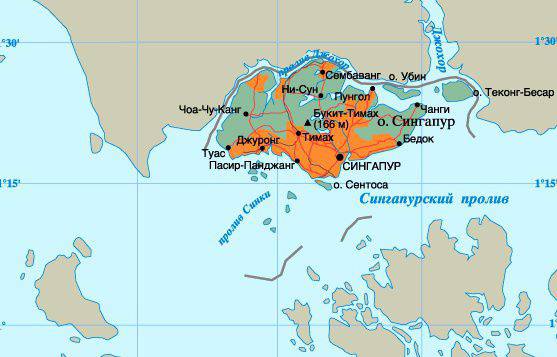 The first mention of the island of Singapore refers to the III. AD - it appears in the Chinese chronicles under the name "Pulozhzhun". In the VIII century. The port of Temasek is being created on the island. It has become one of the centers of the sea trade of the Indonesian state Shrivijaya. However, in 1613, the port was destroyed during an attack by a detachment from the Sumatran Sultanate of Aceh. After this strike, the port did not recover, and only at the beginning of the XIX century, the British noticed the island. The fact is that before the Napoleonic wars, the Netherlands had the most stable political and economic positions in Southeast Asia. They controlled almost the entire Malay Archipelago and Ceylon. After the end of the Napoleonic wars, the British, who occupied the Dutch colonial possessions, left Ceylon and the Cape land under their rule, but gave the rest of the colonies to the Netherlands. In the Strait of Malacca, only the Penang remained in the hands of the British. However, the British political and economic circles thought about the need to further strengthen their positions in Southeast Asia, above all - in the Malacca Strait.
The first mention of the island of Singapore refers to the III. AD - it appears in the Chinese chronicles under the name "Pulozhzhun". In the VIII century. The port of Temasek is being created on the island. It has become one of the centers of the sea trade of the Indonesian state Shrivijaya. However, in 1613, the port was destroyed during an attack by a detachment from the Sumatran Sultanate of Aceh. After this strike, the port did not recover, and only at the beginning of the XIX century, the British noticed the island. The fact is that before the Napoleonic wars, the Netherlands had the most stable political and economic positions in Southeast Asia. They controlled almost the entire Malay Archipelago and Ceylon. After the end of the Napoleonic wars, the British, who occupied the Dutch colonial possessions, left Ceylon and the Cape land under their rule, but gave the rest of the colonies to the Netherlands. In the Strait of Malacca, only the Penang remained in the hands of the British. However, the British political and economic circles thought about the need to further strengthen their positions in Southeast Asia, above all - in the Malacca Strait. One of the most ardent supporters of the idea of creating a British trading post in the Malacca Strait was Stamford Raffles, who served in the British East India Company. Interestingly, Sir Thomas Stamford Bingley Raffles (1781-1826) himself was half Dutch - his father was a British captain, and his mother was Dutch. Raffles served in the East India Company, was fluent in Malay, so in 1810 he was sent by the Governor-General of British India to Malacca as the local governor. During the Napoleonic Wars, Raffles led a British expedition to Java and was appointed by the British Governor-General of Java. For services to the British crown in 1817, Mr. Raffles was knighted. In 1818, the authorities of British India gave Raffles welcome to equip the expedition and create a British base at the southern entrance to the Strait of Malacca. The creation of this base, according to Raffles, should have seriously undermined the position of the Netherlands, which controlled European trade with China.
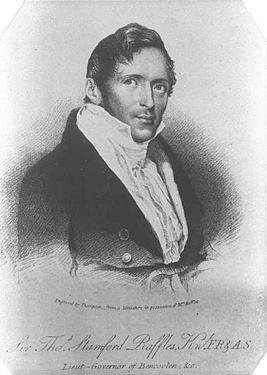 28 January 1819, a British squadron of eight men landed on the island of Singapore. By the time the British landed, the commercial port that had once operated on the island had long been abandoned. The island was inhabited by a small tribe of orangs Lauta - "sea people", fishing. In addition, the ruler of Singapore, Ding Abdurrahman, lived in the south of the island and bore the title of Temenggung and claimed power over the South Malaysian lands. As a result of short-term negotiations, Raffles managed to obtain permission from the Temenggung Daing Abdurrahman to set up a trading post. For this, the British promised to pay the local feudal 3 thousands of Malaysian dollars annually. Raffles brought Prince Hussein to the island, who was removed from power in the sultanate of Riau-Johor, and proclaimed him the Sultan of Singapore. In 1823, Sultan Hussein and Temenggung Abdurrahman signed a waiver of all rights and claims to the territory of Singapore, with the exception of their own residences. So Singapore became a British colony, despite the opposition of the Netherlands. In 1824, an agreement was concluded between Great Britain and the Netherlands, according to which the Netherlands refused Malacca and transferred it to the British, recognized the latter’s right to own Singapore, but, in turn, were rejected by the British from their previous possessions in Sumatra and from any claims and political games in Sumatra. Thus, in fact, there was an exchange of Dutch possessions in Malacca for British possessions in Sumatra. As it turned out later - the British did not lose. Singapore really had a very favorable geographical location. In fact, it was during the period of British rule that Singapore emerged as a shopping center for Southeast Asia. In Singapore, the British administration, judicial, police and educational systems of the European type were created, high taxes on the sale of alcohol and opium were introduced, and the sale of slaves was prohibited.
28 January 1819, a British squadron of eight men landed on the island of Singapore. By the time the British landed, the commercial port that had once operated on the island had long been abandoned. The island was inhabited by a small tribe of orangs Lauta - "sea people", fishing. In addition, the ruler of Singapore, Ding Abdurrahman, lived in the south of the island and bore the title of Temenggung and claimed power over the South Malaysian lands. As a result of short-term negotiations, Raffles managed to obtain permission from the Temenggung Daing Abdurrahman to set up a trading post. For this, the British promised to pay the local feudal 3 thousands of Malaysian dollars annually. Raffles brought Prince Hussein to the island, who was removed from power in the sultanate of Riau-Johor, and proclaimed him the Sultan of Singapore. In 1823, Sultan Hussein and Temenggung Abdurrahman signed a waiver of all rights and claims to the territory of Singapore, with the exception of their own residences. So Singapore became a British colony, despite the opposition of the Netherlands. In 1824, an agreement was concluded between Great Britain and the Netherlands, according to which the Netherlands refused Malacca and transferred it to the British, recognized the latter’s right to own Singapore, but, in turn, were rejected by the British from their previous possessions in Sumatra and from any claims and political games in Sumatra. Thus, in fact, there was an exchange of Dutch possessions in Malacca for British possessions in Sumatra. As it turned out later - the British did not lose. Singapore really had a very favorable geographical location. In fact, it was during the period of British rule that Singapore emerged as a shopping center for Southeast Asia. In Singapore, the British administration, judicial, police and educational systems of the European type were created, high taxes on the sale of alcohol and opium were introduced, and the sale of slaves was prohibited. The capital of the “Torrential settlements”
In 1826 was Penang, Malacca and Singapore became part of the united British colony of the Straits Settlements (the “Torrential Settlements”). From this time and over the next 125 years, Singapore developed as a British colony within the Straits Settlements. In 1830 was Straits Settlements received the status of residence of British Bengal. The administrative center of the colony was moved to 1832. from georgiatown on penang to singapore. Since 1851 The Straits Settlements were placed under the control of the Governor General of British India, but in 1867 withdrawn from British India and formed a separate colony - the Crown colony of the Straits Setments, which also included Christmas Island and Cocos Islands. When in 1896 The administration of the Federated Malayan States, which included Pahang, Perak, Selangor, and Negri-Sembilan, was established; Governor Straits Settlements became head of administration. In 1909 was Governors of the Straits Settlements were also subject to the British protectorate of North Borneo, Brunei and Sarawak. The rapid development of maritime trade has contributed to the influx into Singapore of a large number of “huaqiao” - ethnic Chinese, who form an impressive diaspora in other countries of Southeast Asia - in Indonesia, Malaysia, the Philippines, and Thailand. The Chinese, in contrast to the small Malaysian peasant population, were more focused on private business. The Chinese, and later the Indians, made up the bulk of the Singapore clerks, small entrepreneurs, technicians and workers in industrial enterprises and in the port. Already in 1830 The Chinese made up about 39% of the population of Singapore, and in 1860, The population of the island’s Chinese population has increased to 63%. Some representatives of the Chinese diaspora were rapidly getting rich, gaining a serious influence in the economic life of the colony. Since Singapore was a port trading city, all the inherent vices such as the opium trade, gambling, and prostitution are widespread in it. Most of the "hot spots" of Singapore was controlled by Chinese secret societies, among which armed clashes periodically flared up. The British administration of Singapore preferred not to interfere in the internal affairs of the Chinese population, since it was concerned only about the control over income derived from the functioning of the port and trade with China and Southeast Asia. In addition to maritime trade, industry and agriculture began to develop in Singapore. In 1890 was A tin smelter was built in 1907. rubber plantations are organized. In addition, coal storages and oil storage facilities on Pulau-Buku Island were opened in Singapore, becoming the largest oil storage facility in Southeast Asia. Back in 1870-s. a telegraph line appeared in Singapore, and then a telephone line. The city rapidly acquired the features of an industrial and commercial center. Naturally, industrial enterprises needed to constantly replenish their cadres - both workers and technical specialists, and clerks. The main influx of immigration to Singapore was due to immigrants from China, to a lesser extent - from India. By the beginning of the twentieth century. Already ¾ of the population of Singapore were Chinese “huaqiao”. A significant part of the Chinese accepted British citizenship and rapidly “Europeanized” in their lifestyle. In 1905 was it was the Chinese diaspora who paid for the opening of a medical college in Singapore. In the city there were six Chinese schools of the modern type. historical homeland. So, in Singapore, branches of the main Chinese political parties operated. Moreover, Chinese political organizations often relied on financial assistance from the wealthy Singaporean Chinese diaspora. The Indian population of Singapore did not have such a strong position as the Chinese. The weakness of the Indian community was compounded by the significant differences that existed between its representatives - immigrants from various ethnic groups and castes of Indian society.
However, the political situation in Singapore with the growth of the national liberation movement in India and the revolutionary movement in China, became increasingly tense. Demonstrations of Indian and Chinese political organizations were regularly held in the city, ending with skirmishes with the police. The socio-economic problems of the Singaporean population, which consisted of crowding, poverty, drug addiction of a significant part of the working people, contributed to the popularization of left and left-wing radical ideas. The most susceptible to leftist ideas were the Chinese - employees and workers of enterprises. They formed the bulk of the activists created in 1930 by the Communist Party of Malaya. By the end of the 1930s. the communist movement in neighboring Malaya gained great influence over Singaporean workers. Workers' strikes broke out constantly in the city, organized by the communists and ended in serious clashes with the police and the arrest of activists of the communist and labor movement. In an effort to reduce the protest activity of the Chinese population, the British authorities of Singapore made a bet on the Malay nationalist movement, the activities of which the colonial administration indulged in every way, realizing that in Singapore, Malay nationalists expressing the opinion of the Malay minority are absolutely safe, but they can interfere with the activities of Chinese political organizations. During World War II, Singapore was besieged by Japanese troops. Singapore's defense in 1942 was the largest defeat of the British army in Southeast Asia and led to the surrender of British troops and fleetstationed in Singapore. The Japanese occupation of Singapore, which began on February 15, 1942, turned into a massive genocide of the Chinese population of the city. In a few days, at least 20 thousand Chinese were killed. The European and Indian populations were driven into concentration camps. The only population group to which the Japanese were more or less normal were Malays. In the Malays, the Japanese saw potential "junior allies," while the Indians and Chinese were seen as subjects of countries with which Japan was at war - China and Britain. Nevertheless, it was on the territory of Singapore that pro-Japanese Indian collaborators headed by Subhas Chandra Bos, who created the Indian National Army and the Provisional Government of Free India, began their activities. Oddly enough, it was Japan’s occupation policy that contributed to the formation of the Singaporean national community, since under the occupation, Singaporeans of both Chinese and Indian origin were subjected to the same oppression and persecution. The Japanese considered them “second-class” people and preferred to nominate representatives of the Malay population of Singapore to serve in the occupying administrative structures.
The path to independence
After the capitulation of Japan and the withdrawal of Japanese troops from Singapore, the population of the city was already different, unlike in its mentality, the pre-war Singaporeans. First of all, Singaporeans started talking about their political rights, especially since throughout Eastern and Southeast Asia, after the end of World War II, national liberation and communist movements became more active. Since the British simply “surrendered” Singapore to the Japanese, after the war, the Singaporean population’s confidence in the British Empire fell sharply. There were changes in the political status of the colony - from 1945 to 1946. Singapore was under the administration of the military administration, and 1 on April 1946, after the abolition of the Straits Settlements colony, Singapore became a separate crown colony. In post-war Singapore, national liberation moods among the population grew, which were aggravated by the socio-economic problems caused by the post-war devastation. The British authorities gradually prepared Malaya and Singapore to provide self-government, for which they formed the Executive and Legislative Councils. The beginning of the civil war in neighboring Malaya, which the Communist Party of Malaya waged against the British administration and the Malay sultans, contributed to the tightening of the internal security regime in Singapore. In the colony, repressions began against the communist movement, in which the British authorities and the big bourgeoisie saw a threat to their domination. Of particular concern to the colonial administration were the close ties of Chinese Communists of Chinese descent with the leadership of the Chinese Communist Party. It is because of the danger of the revitalization of the Communists in Singapore that work on the transition of the city to self-government was suspended for several years. Only in 1959, Singapore was declared an autonomous state within the British Commonwealth, the actual management of which passed into the hands of the prime minister elected by the Legislative Assembly. The first prime minister of Singapore was Chinese Lee Kuan Yew (1923-2015) - a lawyer, leader of the Popular Action Party and a prominent trade union leader of Singapore.
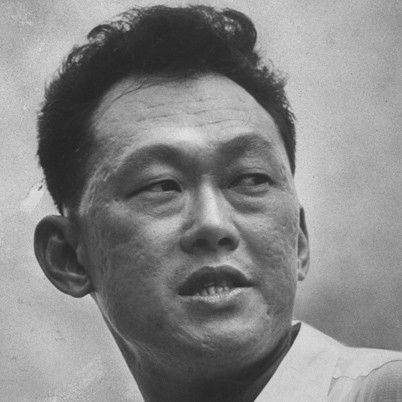 R ›Рё РљСѓР ° РЅ Р® Р ± С‹ Р »РєРѕСЂРµРЅРЅС‹ Рј СЃРёРЅРіР ° РІСѓСЂС † ем - “РѕРЅ СЂРѕРґРёР” СЃСЏ РІ РЎРёРіРіР ° RџSЂR ° F RґRμRґ> Pd RљSѓR ° of the PS R®, RїSЂRμRґSЃS,R ° RІRoS,RμR "SЊ SЋR¶RЅRѕRєRoS,R ° R№SЃRєRѕR№ RЅR SЂRѕRґRЅRѕSЃS,Ro ° C ° F ... RєRєR °, ± RїSЂRoR C <P" RЅR ° остров РІ серединеРXIX XIX векР°. Р ›Рё РљСѓР ° РЅ Р® РїРѕР» СѓС ‡ РёР »РѕР ± СЂР ° Р · РѕРІР ° РЅРёРµ РІ СЃРёРЅРіР ° РїСѓСЂСЃРєРѕР№ РЅР ° С З R ° Р» СЊРЅРєРѕР ° С RμRј â € "The PI" P ° C P "C" P "· R -RєRѕR" P "RμRґR¶RμV" PI P> RѕRЅRґRѕRЅSЃRєRѕR№ C € RєRѕR "Rμ SЌRєRѕRЅRѕRјRoRєRo Ryo PI RљRμRјR ± SЂRoRґR¶SЃRєRѕRј SѓRЅRoRІRμSЂSЃRoS,RμS,Rμ . P '1949 Pі. P> Pd RљSѓR ° of the PS R® RІRμSЂRЅSѓR "SЃSЏ PI RЎRoRЅRіR RїSѓSЂ Pd ° F · ° F RЅSЏR" SЃSЏ ° C ‡ P SЃS,RЅRѕR№ ° F RґRІRѕRєR ° S,SЃRєRѕR№ RїSЂR ° RєS,RoRєRѕR№. Р'Рѕ время СЂР ° Р ± РѕС‚С ‹Р ° РґРІРѕРєР ° том РѕРЅ предостР° РІР P '1954 Pі. P> Pd RљSѓR ° of the PS R® RѕSЃRЅRѕRІR ° F "RџR ° SЂS,RoSЋ RЅR ° SЂRѕRґRЅRѕRіRѕ RґRμR№SЃS,RІRoSЏ, RoSЃRїRѕRІRμRґRѕRІR ° RІS € SѓSЋ RїSЂR ° RІRѕSЃRѕS Röhr ° F †" ‡ RoSЃS,RoS RμSЃRєRoRμ RoRґRμRo. Р 'РїР ° ртии Р ›Рё РљСѓР ° РЅ Р® РРРРСРРРРРРРРРРРРРРРРРРРРРРПРРРРРРР SЂSЏ, P ° 1959 PI PI., PI RІRѕR · SЂR ° SЃS,Rμ 36 P "RμS,, SЃS,R ° F" RїRμSЂRІS <Rј RїSЂRμRјSЊRμSЂ-RјRoRЅRoSЃS,SЂRѕRј RЎRoRЅRіR ° RїSѓSЂR °. R • РјСѓ СѓРґР ° Р »РѕСЃСЊ СЃРѕС ... СЂР ° нять Р · Р ° СЃРѕР ± РѕР№ РїРѕСЃС‚ времьер-РјРёРЅРРРРРРРРРРРРРРРРРРРРРРРРРРРРРРРРРРРРРРРРРРРРРРРРРРРРРРРРРРРРРРРРРРРРРРРРРРРРРРРРРРРРРРРРРРРРРРРРРРРРРРРРРРР ‚-“ P ”RёS € СЊ РІ 30 Рі. P> Ryo RљSѓR ° of the PS R® SѓS € RμR "PI RѕS,SЃS,R ° RІRєSѓ SЃ RїRѕSЃS,R RіR °" P ° RІS <SЃRoRЅRіR ° RїSѓSЂSЃRєRѕRіRѕ RїSЂR RІRoS,RμR ° "° SЊSЃS,RІR, RѕSЃS,R ° RІS € RoSЃSЊ PI RoSЃS,RѕSЂRoRo C "P ° RєS,RoS RμSЃRєRoRј SЃRѕR ‡ · ° RґR S,RμR" RμRј SЃRѕRІSЂRμRјRμRЅRЅRѕRіRѕ RЅRμR · P ° RІRoSЃRoRјRѕRіRѕ RЎRoRЅRіR RїSѓSЂR ° °. P '1990 Pі. RЎRoRЅRіR ° RїSѓSЂ, RѕRїR ° SЃR ° SЏSЃSЊ RІRѕR · RјRѕR¶RЅRѕRіRѕ RєRѕRјRјSѓRЅRoSЃS,RoS ‡ RμSЃRєRѕRіRѕ RІRѕSЃSЃS,R ° RЅRoSЏ, RІRѕS € RμR "PI PI SЃRѕSЃS,R ° R¤RμRґRμSЂR ° C RoRo RњR ° † P" P ° R№ P , тР° РєРёРј РѕР ± СЂР ° Р · РѕРј, РѕР ± еР· РѕРїР ° сить сеР± СЏ РѕС ‚РІРѕР · можной СѓРіСЂРѕР · С‹ РІ Р Р РЕРІ RЕРІ RЕРІ RЕРІ РЕРІ РЕ РІ РЕРІ СЂР ° РґРёРєР ° Р »РѕРІ. РћРґРЅР ° РєРѕ РІ состР° РІРµ РњР ° Р »Р ° Р№Р · РёРё РЎРёРЅРіР ° РїСѓСЂСѓ Р ± С‹ Р РџСЂРёС З РёРЅРѕР№ СЂР ° сторжения СЃРѕРіР »Р ° С € ения РѕР ± РѕР ± ъединениииКРРР °Р РР РР ° Р№ РІС ‹С‚Р ° Р» СЃСЏ РєРѕРЅСЃРѕР »РёРґРёСЂРѕРІР ° ть РІСЃРµ китР° Р№СЃРєРѕРµ РЅР ° сел ение РІРѕСЃРІСР °Р °Р °СРЃР ° »СЊС € инство РІ РЎРёРЅРіР ° РїСѓСЂРµ Рё РЅРµ менее трети РЅР ° сел ения РІ РњР ° Р »Р ° Р№Р · РёР. Р 'реР· СѓР »СЊС‚Р ° те, РјР ° Р» Р ° Р · РёР№СЃРєРёР№ РїР ° СЂР »Р ° мент РІСЂРёРЅСЏР » РёР · состР° РІР ° ФедерР° С † РёРё РњР ° Р »Р ° Р№Р · РёРё. 1963 ° F RІRіSѓSЃS,R ° 9 RіRѕRґR ° C ± P <P "P ° RїSЂRѕRІRѕR RіR ·" F ° C ° € RμRЅR RїRѕR "‡ RoS,RoS RμSЃRєR ° SЏ RЅRμR · ° F RІRoSЃRoRјRѕSЃS,SЊ RЎRoRЅRіR ° RїSѓSЂR °. РўР ° Рє РЅР ° РєР ° рте Юго-Р'РѕСЃС‚РѕС З РЅРѕР№ РђР · РёРё РІРѕСЏРІРёР 2015 сентяР± СЂСЏ 21 Рі. РЎРёРЅРіР ° РїСѓСЂ Р ± С ‹Р» РїСЂРёРЅСЏС ‚РІ состР° РІ РћСЂРіР ° РЅРёР · Р ° С † РёРё РћР ± ъединенны С… РќР№Р№Р.
R ›Рё РљСѓР ° РЅ Р® Р ± С‹ Р »РєРѕСЂРµРЅРЅС‹ Рј СЃРёРЅРіР ° РІСѓСЂС † ем - “РѕРЅ СЂРѕРґРёР” СЃСЏ РІ РЎРёРіРіР ° RџSЂR ° F RґRμRґ> Pd RљSѓR ° of the PS R®, RїSЂRμRґSЃS,R ° RІRoS,RμR "SЊ SЋR¶RЅRѕRєRoS,R ° R№SЃRєRѕR№ RЅR SЂRѕRґRЅRѕSЃS,Ro ° C ° F ... RєRєR °, ± RїSЂRoR C <P" RЅR ° остров РІ серединеРXIX XIX векР°. Р ›Рё РљСѓР ° РЅ Р® РїРѕР» СѓС ‡ РёР »РѕР ± СЂР ° Р · РѕРІР ° РЅРёРµ РІ СЃРёРЅРіР ° РїСѓСЂСЃРєРѕР№ РЅР ° С З R ° Р» СЊРЅРєРѕР ° С RμRј â € "The PI" P ° C P "C" P "· R -RєRѕR" P "RμRґR¶RμV" PI P> RѕRЅRґRѕRЅSЃRєRѕR№ C € RєRѕR "Rμ SЌRєRѕRЅRѕRјRoRєRo Ryo PI RљRμRјR ± SЂRoRґR¶SЃRєRѕRј SѓRЅRoRІRμSЂSЃRoS,RμS,Rμ . P '1949 Pі. P> Pd RљSѓR ° of the PS R® RІRμSЂRЅSѓR "SЃSЏ PI RЎRoRЅRіR RїSѓSЂ Pd ° F · ° F RЅSЏR" SЃSЏ ° C ‡ P SЃS,RЅRѕR№ ° F RґRІRѕRєR ° S,SЃRєRѕR№ RїSЂR ° RєS,RoRєRѕR№. Р'Рѕ время СЂР ° Р ± РѕС‚С ‹Р ° РґРІРѕРєР ° том РѕРЅ предостР° РІР P '1954 Pі. P> Pd RљSѓR ° of the PS R® RѕSЃRЅRѕRІR ° F "RџR ° SЂS,RoSЋ RЅR ° SЂRѕRґRЅRѕRіRѕ RґRμR№SЃS,RІRoSЏ, RoSЃRїRѕRІRμRґRѕRІR ° RІS € SѓSЋ RїSЂR ° RІRѕSЃRѕS Röhr ° F †" ‡ RoSЃS,RoS RμSЃRєRoRμ RoRґRμRo. Р 'РїР ° ртии Р ›Рё РљСѓР ° РЅ Р® РРРРСРРРРРРРРРРРРРРРРРРРРРРПРРРРРРР SЂSЏ, P ° 1959 PI PI., PI RІRѕR · SЂR ° SЃS,Rμ 36 P "RμS,, SЃS,R ° F" RїRμSЂRІS <Rј RїSЂRμRјSЊRμSЂ-RјRoRЅRoSЃS,SЂRѕRј RЎRoRЅRіR ° RїSѓSЂR °. R • РјСѓ СѓРґР ° Р »РѕСЃСЊ СЃРѕС ... СЂР ° нять Р · Р ° СЃРѕР ± РѕР№ РїРѕСЃС‚ времьер-РјРёРЅРРРРРРРРРРРРРРРРРРРРРРРРРРРРРРРРРРРРРРРРРРРРРРРРРРРРРРРРРРРРРРРРРРРРРРРРРРРРРРРРРРРРРРРРРРРРРРРРРРРРРРРРРРР ‚-“ P ”RёS € СЊ РІ 30 Рі. P> Ryo RљSѓR ° of the PS R® SѓS € RμR "PI RѕS,SЃS,R ° RІRєSѓ SЃ RїRѕSЃS,R RіR °" P ° RІS <SЃRoRЅRіR ° RїSѓSЂSЃRєRѕRіRѕ RїSЂR RІRoS,RμR ° "° SЊSЃS,RІR, RѕSЃS,R ° RІS € RoSЃSЊ PI RoSЃS,RѕSЂRoRo C "P ° RєS,RoS RμSЃRєRoRј SЃRѕR ‡ · ° RґR S,RμR" RμRј SЃRѕRІSЂRμRјRμRЅRЅRѕRіRѕ RЅRμR · P ° RІRoSЃRoRјRѕRіRѕ RЎRoRЅRіR RїSѓSЂR ° °. P '1990 Pі. RЎRoRЅRіR ° RїSѓSЂ, RѕRїR ° SЃR ° SЏSЃSЊ RІRѕR · RјRѕR¶RЅRѕRіRѕ RєRѕRјRјSѓRЅRoSЃS,RoS ‡ RμSЃRєRѕRіRѕ RІRѕSЃSЃS,R ° RЅRoSЏ, RІRѕS € RμR "PI PI SЃRѕSЃS,R ° R¤RμRґRμSЂR ° C RoRo RњR ° † P" P ° R№ P , тР° РєРёРј РѕР ± СЂР ° Р · РѕРј, РѕР ± еР· РѕРїР ° сить сеР± СЏ РѕС ‚РІРѕР · можной СѓРіСЂРѕР · С‹ РІ Р Р РЕРІ RЕРІ RЕРІ RЕРІ РЕРІ РЕ РІ РЕРІ СЂР ° РґРёРєР ° Р »РѕРІ. РћРґРЅР ° РєРѕ РІ состР° РІРµ РњР ° Р »Р ° Р№Р · РёРё РЎРёРЅРіР ° РїСѓСЂСѓ Р ± С‹ Р РџСЂРёС З РёРЅРѕР№ СЂР ° сторжения СЃРѕРіР »Р ° С € ения РѕР ± РѕР ± ъединениииКРРР °Р РР РР ° Р№ РІС ‹С‚Р ° Р» СЃСЏ РєРѕРЅСЃРѕР »РёРґРёСЂРѕРІР ° ть РІСЃРµ китР° Р№СЃРєРѕРµ РЅР ° сел ение РІРѕСЃРІСР °Р °Р °СРЃР ° »СЊС € инство РІ РЎРёРЅРіР ° РїСѓСЂРµ Рё РЅРµ менее трети РЅР ° сел ения РІ РњР ° Р »Р ° Р№Р · РёР. Р 'реР· СѓР »СЊС‚Р ° те, РјР ° Р» Р ° Р · РёР№СЃРєРёР№ РїР ° СЂР »Р ° мент РІСЂРёРЅСЏР » РёР · состР° РІР ° ФедерР° С † РёРё РњР ° Р »Р ° Р№Р · РёРё. 1963 ° F RІRіSѓSЃS,R ° 9 RіRѕRґR ° C ± P <P "P ° RїSЂRѕRІRѕR RіR ·" F ° C ° € RμRЅR RїRѕR "‡ RoS,RoS RμSЃRєR ° SЏ RЅRμR · ° F RІRoSЃRoRјRѕSЃS,SЊ RЎRoRЅRіR ° RїSѓSЂR °. РўР ° Рє РЅР ° РєР ° рте Юго-Р'РѕСЃС‚РѕС З РЅРѕР№ РђР · РёРё РІРѕСЏРІРёР 2015 сентяР± СЂСЏ 21 Рі. РЎРёРЅРіР ° РїСѓСЂ Р ± С ‹Р» РїСЂРёРЅСЏС ‚РІ состР° РІ РћСЂРіР ° РЅРёР · Р ° С † РёРё РћР ± ъединенны С… РќР№Р№Р. The young sovereign state experienced many serious socio-economic problems associated with the problematic existence of such a small state. In Singapore, there was 10-12% unemployment, a significant part of the population experienced housing problems, and there was a shortage of fresh water. All this was aggravated by the active propaganda activities of local communists, who were under the influence of the Chinese Communist Party. Therefore, the first Singaporean government faced the question of the need for a tough domestic policy aimed at suppressing any opposition sentiment, a resolute struggle against crime and radical political trends. Prior to 1968, British troops were based in Singapore, which constituted the forceful support of the authoritarian regime established in a young country by Prime Minister Lee Kuan Yew. However, in addition to a tough domestic security policy, the government of Lee Kuan Yew carried out very effective economic modernization of Singapore. The country's leadership set a course for turning Singapore into an industrial and scientific-technological center, for which it began to invest serious funds in the development of education, science and technology, and the manufacturing industry. The basis for the economic development of post-war Singapore was the increase in turnover of the Singapore port, achieved through tax breaks, and the opening of oil refineries in Singapore, which turned the country into the third largest oil refining center in the world. At the same time, considerable funds were also invested in the modernization of the social infrastructure, primarily in the solution of the housing problem and in the modernization of vocational education. The desire to solve the housing problem has stimulated high-rise construction in small Singapore, which simply had nowhere to expand. The Directorate of Real Estate initiated the mass construction of housing estates in which 80-90% of the Singaporean population lives today. As part of the solution to the housing problem, the famous Singapore slums were demolished, which made it possible to build multi-storey housing estates on the site of one-story slum settlements. 1987 also launched the Singapore Metro. As for the field of vocational education, emphasis was placed on training highly skilled workers for the needs of industry.
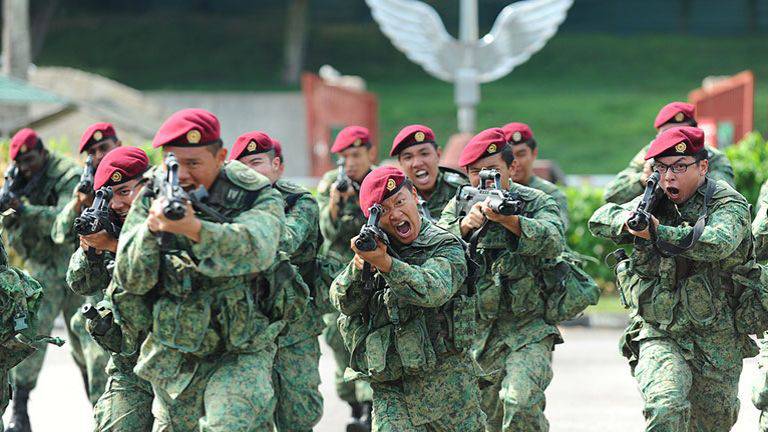
Constant concerns about the possibility of internal communist uprisings or the invasion of Malaysia or Indonesia led Singapore to attend to the creation and modernization of its own armed forces. Equipped with the help of the United States of America, Great Britain and Israel, the Singapore army, despite its relatively small size, has become one of the best-prepared and armed armies of Southeast Asia. It numbers 72 thousands of people, including ground forces, air force and naval forces. Singapore plays an important role in the security system in Southeast Asia and performs essential functions in the international fight against terrorism. Incidentally, Israeli military advisers, including Colonel Yakov Elazari, who was responsible for creating staff units, and Lieutenant Colonel Yehuda Golani, who was in charge of creating the Singapore infantry, were directly in charge of the creation of the Singapore army. Israeli officers led the Armed Forces Training Center and the Command and Staff College, and the establishment of the Singapore Air Force was under the direction of Israeli advisers. Colonel Adam Tsivoni, who led the technical department of the Israeli Air Force headquarters, was appointed responsible adviser to the Singapore Air Force. Military-political ties between Singapore and Israel remain up to the present - the “lion city” is an important consumer of the products of the Israeli military industry, and in addition, weapons are delivered to the Indochina countries, particularly Myanmar, through Singapore. In addition, the Singapore Army has strong ties with the armed forces of the United States and Australia, with whom joint exercises and training sessions take place. In recent years, interaction has been established with the security forces of neighboring countries - Malaysia, Indonesia, Brunei. Singapore units participate in joint exercises with representatives of the armies and security forces of neighboring countries.
The model of organization of the Israel Defense Forces was used in the construction of the armed forces of Singapore and because the Singaporean army had, in addition to the country's defense, to perform the task of integrating various ethnic and religious groups of the country into a single political nation similar to the Israeli army. Army service was best suited to attain the goal of shaping Singapore identity. Moreover, in Singapore, a general call was made to serve in the armed forces, so that the Chinese were shoulder to shoulder with the Chinese, Indians, Malays, and representatives of other ethnic groups living in Singapore. In addition to the armed forces proper, a brigade of Gurkhas is deployed in Singapore — elite troops recruited from the Nepalese highlanders under contract. Singapore, in addition to Britain and Brunei itself, is one of the few countries - the former British colonies that preserve the old tradition of serving the Nepalese Gurkha. In Singapore, the gurkhas are busy maintaining public order and protecting the personal safety of members of the political elite of Singaporean society. At the same time, Gurkha serving in Singapore under contract, have no right to marry local women and have a number of restrictions aimed at preventing their possible subsidence in the territory of Singapore.
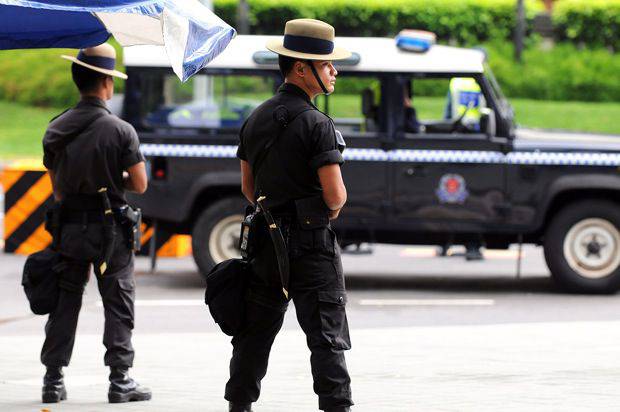
"Asian Tiger"
In the course of half a century, Singapore has become the country with the least risk for foreign investments in 2, after Switzerland, and 1 in the world in terms of the convenience of doing business. On the territory of Singapore, there are branches and branches of 3,5 of thousands of international companies, and by the number of large banks, Singapore ranks third after London and New York. In Singapore, there are strict bank secrecy laws, which provide the country with competitive advantages even in comparison with the “main bank of the world” Switzerland. The basis of the Singapore economy remains maritime trade and shipping, banking, tourism and the petroleum industry. These sectors of the economy provide the bulk of revenue to the Singapore budget. At the same time, Singapore can hardly be called a democratic country in the sense that is used in this term in the West. Thus, the first prime minister, Lee Kuan Yew, was at his post for more than thirty years, and at present, his eldest son, Li Xianlong (born 1952), occupies the premiership. The President of Singapore is Tony Tan Kem Yam (born 1940) - a businessman, mathematician and politician who at one time held the posts of Minister of Defense of Singapore and Deputy Prime Minister of the Singapore Government. Power in Singapore was in the hands of representatives of a narrow stratum of the political and business elite. The country has fairly tough laws regarding corruption, drug trafficking. Even street behavior of citizens - and that is regulated, primarily due to high fines for any, including the most insignificant at first glance offenses - such as a cigarette butt thrown past the urn, spitting on the asphalt, crossing the road in the wrong place or smoking in a public place Moreover, for some of these faults one can get not only a high fine, but also a couple of months in prison. There are also corporal punishments in Singapore, also imposed for all kinds of offenses. Such tough legislation, however, contributes to maintaining a very high level of public order protection for a trade port in Singapore.
At one time, Prime Minister Lee Kuan Yew managed to achieve almost complete eradication of corruption in the country - fiction for the Asian state. Later, the prime minister described the situation in the country that had developed by 1960 in the following years: “corruption is one of the features of the Asian way of life. People openly accepted rewards, it was a part of their life. ” For corruption, cruel punishments were introduced; at the same time, the salaries of judges were raised to 1 million dollars a year, which made it possible to eradicate corruption in the judiciary. In addition, Lee Kuan Yew dispersed the old colonial police and replaced its personnel with new police officers. The Prime Minister managed to do away with the immortal Chinese triads that had led the shadow economy of the island state since the 19th century. The government’s anti-corruption measures led to the arrest or suicide of even members of the top Singapore political elite. In particular, the Minister of the Environment Vi T Bun was imprisoned for committing crimes of a corruption nature.
The effectiveness of the social policy of the Singapore authorities is obvious to anyone who comes to a state attributable to the so-called. "Asian tigers". In forty years, the life expectancy of Singaporeans has increased from 66 to 82 years, becoming one of the largest in Asia and in the world as a whole. In many ways, a high level of life expectancy has been achieved by getting rid of epidemics from which residents of all countries of the region have suffered before, as well as a tough fight against alcoholism, smoking and drug addiction. At the same time, Singapore is called the most expensive country in the world. Not only are penalties for disturbing public order high, but prices for housing, food, and even the use of roads are high. Singapore has a very high rental rate - renting a room costs around 500 Singapore Dollars, and apartments - Singapore 3000 dollars. At the same time, the average salary in the country is also in the area of 2-4 thousands of Singapore dollars per month. It is almost impossible to buy housing for a representative of the proletarian segments of the population. At the same time, Singapore, according to many of its inhabitants and tourists visiting it, is among the safest countries and cities in the world. It is virtually no crime, defeated drug addiction (for the drug trafficking in Singapore should be the death penalty - even for relatively small batches of drugs). One more distinctive feature of Singapore is the general internetization and informatization of the city - state. So, it was in Singapore for the first time in the world that the project of creating an “electronic government” was launched. With the help of computer systems, traffic control, charging for the use of roads, etc. are carried out. The country's authorities are also serious about the problem of ensuring information security - even connecting to someone else's Wi Fi network can be completed up to three years in prison (in practice, of course, such lengthy terms are rare, but the punishment still follows - usually in a very impressive fine). Until recently, Singapore did not know national problems, since the country had introduced four state languages - English, Malay, Chinese and Tamil (Dravidian language Tamils - people from South India, constituting the majority of Indian migrants and their descendants living in Singapore). Nevertheless, the intensification of radical fundamentalism among the Muslim population of neighboring Indonesia and Malaysia contributed to the emergence of the first radical fundamentalists among Singaporean citizens - usually of Malay or Indian origin. However, the Singapore government is very severely punishing any manifestations of political and religious extremism. Today, turning into one of the “Asian tigers”, Singapore is developing rapidly and dynamically, although this country is not devoid of numerous social problems that have accumulated over half a century of existence of an independent Singaporean statehood.
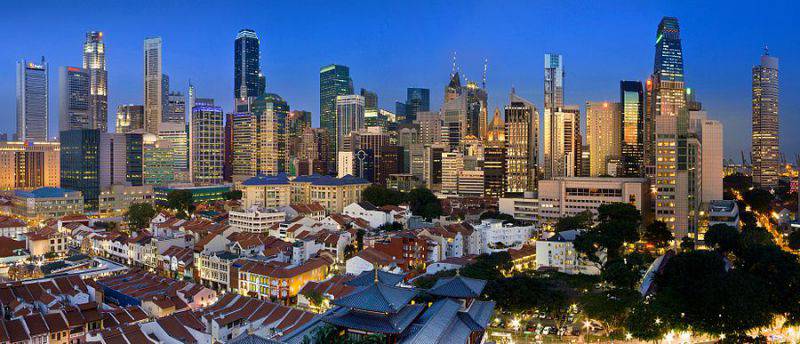
Information